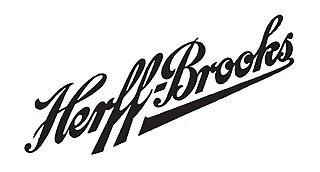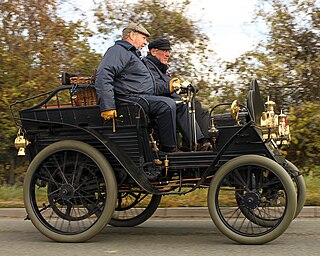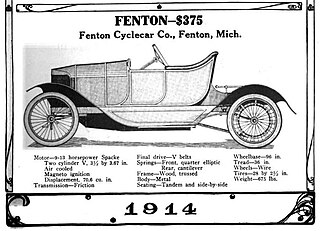
Herff–Brooks Corporation was a brass era automobile manufacturer based in Indianapolis, Indiana, in 1914 to 1916.
The Aland was a four-cylinder 2.5-liter 16-valve, single OHC automobile with diagonally connected four-wheel internal expanding brakes and aluminum pistons. It was made in Detroit, Michigan, by the Aland Motor Car Company from 1916 to 1917. Two- and five-seater versions were available for $1500.

The Mors automobile factory was an early French car manufacturer. It was one of the first to take part in automobile racing, beginning in 1897, due to the belief of the company founder, Émile Mors, in racing's technical and promotional benefits. By the turn of the century, automobile racing had become largely a contest between Mors and Panhard et Levassor.

F. B. Stearns and Company, later known as F. B. Stearns Company was an American manufacturer of luxury cars in Cleveland, Ohio marketed under the brand names Stearns from 1900 to 1911 then Stearns-Knight from 1911 until 1929.

The Queen was a Brass Era American automobile manufactured between 1904 and 1907 in Detroit, Michigan.
The Rayfield was an American automobile marque manufactured from 1911 until 1915 by the Rayfield Motor Car Company, first in Springfield, Illinois and then in Chrisman, Illinois.
The Davis was an American cyclecar manufactured in Detroit, Michigan, by the Davis Cyclecar Company in 1914. The car used a two-cylinder Spacke air-cooled engine, and featured three-speed selective transmission and a double chain drive on a 93-inch wheelbase. The Davis was similar to the French Bédélia in that the driver sat in the rear seat. The tandem two-seater cost $425, but designer William Norris Davis was unable to secure the capital to undertake production. He moved to the West Coast and joined the Los Angeles Cyclecar Company.

The Hackett was an automobile built in Jackson, Michigan, United States, by the Hackett Motor Car Company from 1916 to 1919.

The JPL was a brass era cyclecar built in Detroit, Michigan by the J.P.L. Cyclecar Company, formed in 1913. Production started in December 1913 but ended in 1914.

The Koppin was a cyclecar built in Fenton, Michigan, by the Koppin Motor Company in 1914.
The Lincoln was a cyclecar or light car built in Detroit, Michigan by the Lincoln Motor Car Company in 1914.
Kauffman Motor Vehicle Company was a pioneer brass era, American automobile company, built in Miamisburg, Ohio, from 1909 until 1912.

The Jackson Automobile Company was an American Brass Era automobile manufacturer located in and named for Jackson, Michigan. The company produced the Jackson from 1903 to 1923, the 1903 Jaxon steam car and the 1904 Orlo.

The Waltham Steam was an American steam car.
The Greyhound Cyclecar Company was created in 1914 in Toledo, Ohio.
The Atlas car was built in Pittsburgh, Pennsylvania, in 1906–1907. The Atlas Automobile Company was established on College Avenue in the East End of Pittsburgh, Pennsylvania in late 1906 in a "fireproof garage." It was a four-cylinder car rated at 25/30 hp with shaft drive and a 3-speed sliding gear transmission. It was offered as a touring car or runabout. The firm was out of business by the next year.
The Brass Era Rex cyclecar was manufactured by the Rex Motor Company in Detroit, Michigan in 1914.

The Kessler Motor Company was a short-lived American manufacturer of aircraft engines and automobiles. The brand name for engines and automobiles was Kessler; also Kess-Line for some cars.

The Signet cyclecar was the name used by Fenton Engineering Company of Fenton, Michigan from 1913 to 1914. In 1914 the name was changed to Fenton and was manufactured by the Fenton Cyclecar Company. In May 1914, The Fenton became the Koppin and was produced by the Koppin Motor Company until September 1914.
The States was a cyclecar manufactured by the States Cyclecar Company of Detroit, Michigan in 1915.










